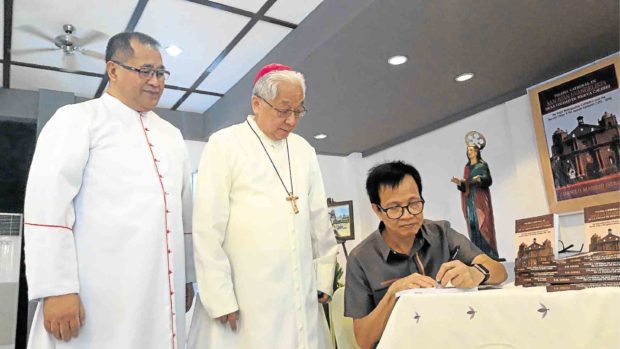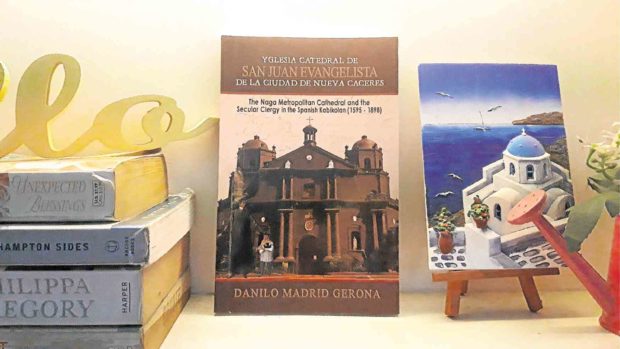New book on Naga cathedral sheds light on Bicol clergy history

BOOK LAUNCH Historian Danilo Madrid Gerona, author of the full-length history book “Yglesia Catedral de San Juan Evangelista de la Ciudad de Nueva Caceres” signs copies for the Archbishop of Caceres, Most Rev. Rolando Tria Tirona (center), and parish priest Rev. Msgr. Noe Badiola (left). —PHOTOS BY Rey Anthony Ostria
NAGA CITY, Camarines Sur, Philippines — One hundred and seventy-six years after the dedication of Naga City’s Metropolitan Cathedral and Parish of St. John the Evangelist, popularly known as the temporary home of Bicol patroness Our Lady of Peñafrancia during her weeklong festival in September, historian Danilo Madrid Gerona and the parish launched the first-ever full-length history book on the cathedral.
The 228-page “Yglesia Catedral de San Juan Evangelista de la Ciudad de Nueva Caceres” sheds light on the beginnings of the Spanish settlements in 16th century Naga to the role of the cathedral in the community from 1843 to the fall of the Spanish hold on the country in 1898.
Rev. Msgr. Noe Badiola said the book was commissioned after discovering that there was not much account on the role of the priests in Naga since the start of the Hispanization of the city.
He said that after looking at the sources in the Spanish archives, he ended up empty-handed. In archives of the Franciscans in San Jose del Monte, he was only able to get the list of priests from San Francisco.
“So if you look at the coffee table book published by the chancery office, you will see there that for the cathedral, there are only four names. And some names were not parish priests, but the assistant priests of the cathedral,” Badiola said.
Article continues after this advertisementFirst full-length book
Article continues after this advertisement“It said that the cathedral is always a work in progress. It is never finished. So all the bishops from before, since the beginning, have contributed to what it is now. Each one, adding to it. It was not only the bishops, but also the curates of the cathedral,” he said.
Gerona said that as one of the first four cathedrals in the country, Naga Metropolitan Cathedral was the first to be featured in a full-length history book.
“I know that very well because before I launched into writing the book, I had to survey the literature about the cathedrals in the Philippines,” he said.
When he was commissioned by the University of San Carlos to write the first history book on Cebu, Gerona said there were no books on the cathedral.
Gerona said Bicol should rejoice that the Naga Metropolitan Cathedral has well-documented materials starting from the beginnings of the church in Bicol.
Bicol was then a poor region and was only able to rise after the discovery of the mines in Paracale town in Camarines Norte province.
The Spaniards, he said, even wanted to leave Nueva Caceres (Naga City’s Spanish name during the colonization period) in 1690.
Cathedrals in history
A petition was granted by the king of Spain, but on the year of the approval, Fr. Miguel Robles de Covarrubias came to Naga and introduced the devotion to Our Lady of Peñafrancia, locally known as “Ina” and the patron saint of the entire Bicol.
He said the cathedral had three roles in the history of Bicol: the beacon of faith, the protector of the natives, and the center of cultural heritage.
Despite having only a few Spanish soldiers against Filipinos, the Spanish settlements thrived in the country because the Church became “the other side of Christianization.
The church played a vital role in sustaining the Spaniards’ agenda in the vast territory of the diocese.

The 228-page “Yglesia Catedral de San Juan Evangelista de la Ciudad de Nueva Caceres” is a history book about Naga City’s Metropolitan Cathedral.
“If Hispanization was harsh on the part of the encomenderos, it was the Church that healed the wounds inflicted,” Gerona said.
“That was what won the hearts of the natives,” he added.
As the fortress of defense of the natives, the cathedral also fought oppressive Spanish institutions.
Spain, concerned about the abuses of the Spanish conquistadors in South America, made sure that there were priests in their expeditions and settlements as the protector of the natives.
“In the 16th Century, if there is a certain priest assigned in the cathedral, he would automatically carry the title of ‘protector de los indios,’” he said.
The archbishop of Caceres issued episcopal rulings on the complaints filed by the natives. As an example, he said people in Paracale would complain about the Spanish encomenderos who were occupying their mines.
By the 19th Century, Naga became the center of cultural heritage due to the elegance of the cathedral.
In 1811, a powerful earthquake reduced to rubble the first cathedral, which was built where the Naga’s public market now stands. By 1843, the new cathedral was completed and was dedicated to St. John the Evangelist.
Research
Eric Lagdameo, a philosophy professor, said Gerona’s book is “a remembrance, a recognition, and research that show why a history book on the cathedral is necessary.”
“The cathedral is not simply an inert reality of stone, brick, mortar and what have you. It is also a social and cultural construct, composed substantially, but not wholly, of individual and collective memories. This book recalls those memories,” Lagdameo said.
He said the book is also a tribute “not only to the people instrumental to this edifice, but also to the edifice itself.”
Sources
One of Gerona’s sources was the Archivo General de Indias in Seville, the archive of the Spanish empire. A document he used from the ecclesiastical section of the archive took him years to study.
Gerona said he read fragile documents as “thick as a one-story building.”
“You touch them, they basically break apart. Those were documents signed by the emperors of Spain—Charles, Philip, and all the Spanish emperors,” he said. Some of the documents were also signed by the bishops of Manila and Caceres.
The diocese of Caceres, at the time, extended as far as Isabela to the north and Marinduque to the south.
Gerona also did an ecclesiastical survey of the documents in Valladolid’s Archivo de Padres Agostinos Filipinos.
First missionaries
The first missionaries in the Philippines were the Augustinians, who came to the Philippines through the expedition of Miguel Lopez de Legazpi in 1565.
The Augustinians also pioneered the missionary work in the Bicol region until 1596 until Franciscans controlled Bicol. For the history of the Franciscans in the region, Gerona had made several visits to the Archivo Franciscano Ibero-Oriental in Madrid.
After 10 visits to the Madrid archives, he said he had only scratched the surface of the rich documents on the Bicol region.